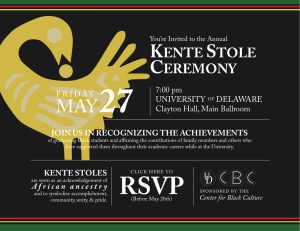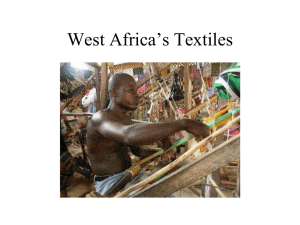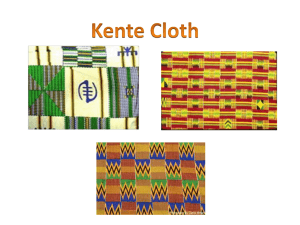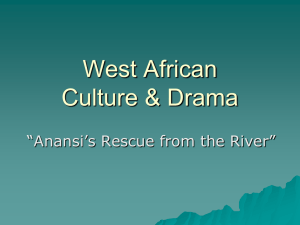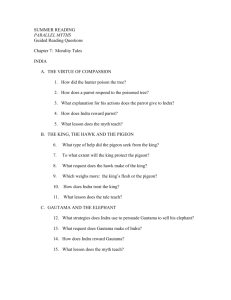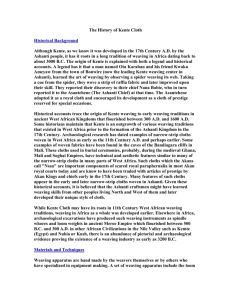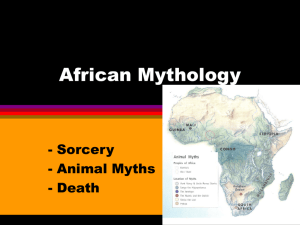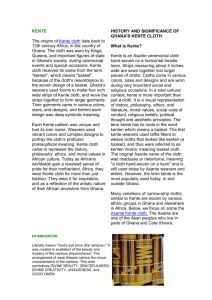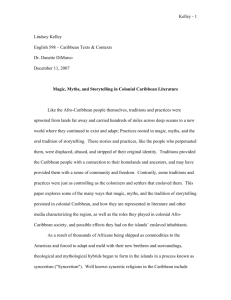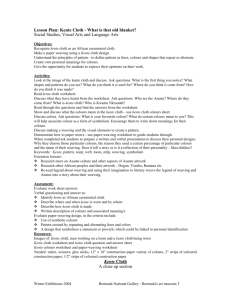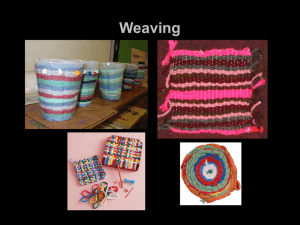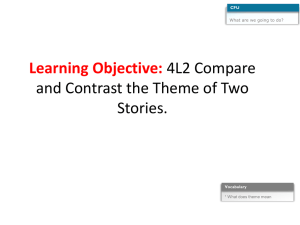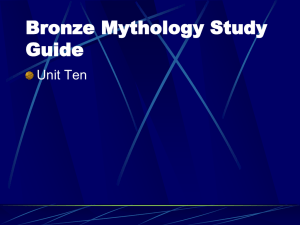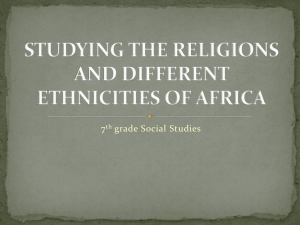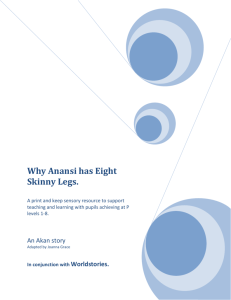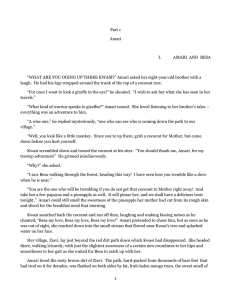Copper Sun by Sharon M. Draper
advertisement
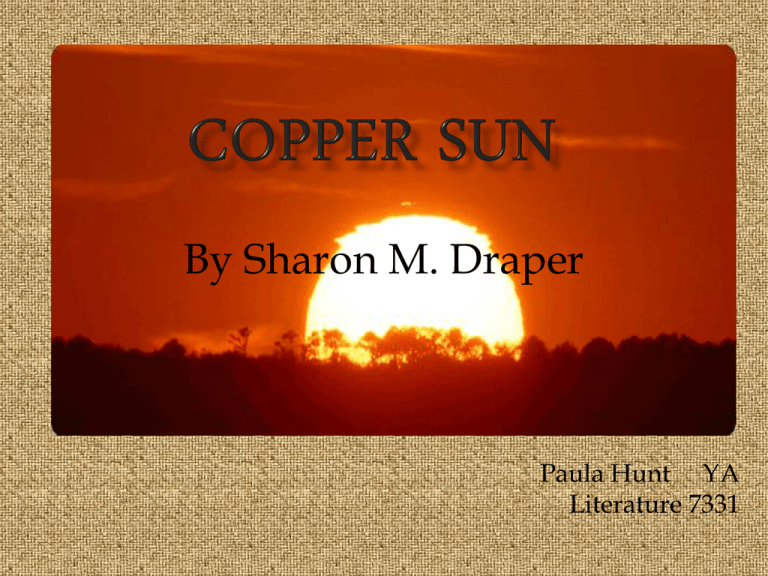
By Sharon M. Draper Paula Hunt YA Literature 7331 Summary of Copper Sun 3 Introduction to Sharon Draper 3 Introduction to Resources 4 African Art/Kente Cloth African Art Projects 5 6 African Folktales Anansi in the Classroom 7 8 The Road to Freedom - Ft. Meso Your Road to Freedom 9 10 Road Trip 11 Sources 12 Sharon Draper is not only a five-time winner of the Coretta Scott King Literary Award (one of which was awarded to Copper Sun) and a New York Times bestselling author, she is a teacher. Ms Draper taught English in Ohio for 30 years. She was honored as the National Teacher of the Year in 1997 and has won numerous other honors for her achievements in education. She calls herself “a creator, a visionary, a poet and a dreamer”. In the first chapter of Copper Sun Amari mentions that she is proud that her father is a weaver of the Ziavi tribe. She loved the bold stripe and animal designs of the tribe’s cloth. Later in the book, we discover that Teenie’s prize possession is a scrape of cloth from her ancestral tribe, the Ashanti. The first resource deals with the art of weaving and the designs found on tribal clothes of Africa. When Teenie gives her pouch containing her cloth to her son Tidbit before he runs away with Amari, she also begs him to remember his ansestors of the Ashanti tribe and the spider and the monkey stories that had passed down through African lore. The second resource is a folktale from Africa about Anansi the spider. Amari, Polly and Tidbit were not servants and slaves on a cotton plantation. Derbyshire Farms was a rice plantation. When they run away, they do not take the more familiar underground railroad. They head south to a lesser known haven. The third activity allows the students to pretend they ran from the rice plantation to Ft. Meso . The trip to the First African Baptist church is to bring a touch of reality and let them see first hand some of the symbols and uncomfortable spaces of freedom. The Ewe say Kente describes the weaving process of the feet. The toe of each foot goes up and down during the weaving process. Ken means to open in Ewe and te means to press.. In the Asante wars against the Ewe, they captured weavers, it may have been prisoners of war from the Asante/Ewe wars that taught the Asante how to weave. The history was rewritten so that the Asante say they learned weaving from a spider. “Amari had often imagined new patterns for the cloth and longed to join the men at the looms, but women were forbidden to do so .” Students may choose from one of three projects: (Websites to help them get started are listed) Research the history of weaving in Guyana: http://kente.midwesttradegroup.com/history.html http://art-smart.ci.manchester.ct.us/fiber-kente/kente.html Design a pattern and explain your design: http://www.marshall.edu/akanart/images/kente_weavingdemo14.JPG http://www.africawithin.com/tour/ghana/kente_cloth.htm Create a weaving using a cardboard loom http://www.craftstylish.com/item/2546/how-to-weave-on-a-cardboard-loom “You remember all them stories I tolt you ‘bout my mother and Ashanti and the monkey and spider stories.” Anansi Stories are part of an ancient mythology that is rooted in West African folklore and deal with semi-divine beings, humans, animals, plants and seemingly inanimate objects. In this traditional Ashanti tale, Anansi sets out on a long, difficult journey. Threatened by Fish and Falcon, he is saved from terrible fates by his sons. But which of his sons should Anansi reward? Calling upon Nyame, the God of All Things, Anansi solves his predicament in a touching and highly resourceful fashion. The teacher will read the story of Anansi aloud. Discussion: Is Anansi a wise creature or merely a trickster? How does this folktale compare to other familiar stories such as Uncle Remus, Aesop’s fables or Native American tales? Question: If you were one of Anansi’s son’s what would your name/power be and what would you have done to rescue Anansi. Class Production: The class will present a skit based on Anansi the Spider. 11 students will be chosen to portray the characters in the story and 1 student will act as the Reader. Remaining students will create simple sets and costumes. The play will be presented as a read-aloud to the school or younger classes while the characters act out the story. When we think about slaves escaping to freedom, we usually visualize them headed north on the underground railroad, but in the first half of the 18th century there was a second haven for runaways. This “city of freedom” could be found about 2 miles north of St. Augustine in the Spanish colony of Florida. It was known as Fort Mose. For more information on Fort Mose go to: Education Foundation Thinkquest Library http:/ http://library.thinkquest.org/CR0213580/ Imagine you are a runaway slave from a rice plantation. You have heard of a city with streets “paved with gold” where everyone is free and it is only a week’s journey south. Create a diary that tells of your life, your journey, your arrival at Fort Mose and the early days of your new life there. Include how you traveled and with whom (if anyone), a simple map, your new home, your new job and the people you met. Tips for writing your journal: •Write the date and your present location at the top of the journal entry. •Write about what happened during the day. •Write about what you're feeling. •Write about what is going on around you. •Don't censor yourself. If you're scared, write why. If you are angry, explain what happened. •Write it from your point of view. First African Baptist Church Savannah, Georgia Established in 1788, the first African church in America was also a safe house on the Underground Railroad. This trip will allow students to experience first hand the symbols used by slaves and the cramped reality of the Underground Railroad to freedom. In preparation of the trip, students should watch the following short videos: http://www.youtube.com/watch?v=mJtTGJl8VB4 http://www.youtube.com/watch?v=b-EvbddTja4 http://art-smart.ci.manchester.ct.us/fiber-kente/kente.html http:/ http://library.thinkquest.org/CR0213580/ http://kente.midwesttradegroup.com/history.html http://sharondraper.com/home.asp http://www.africawithin.com/tour/ghana/kente_cloth.htm http://www.craftstylish.com/item/2546/how-to-weave-on-a-cardboard-loom http://www.marshall.edu/akanart/images/kente_weavingdemo14.JPG http://www.notablebiographies.com/news/Ca-Ge/Draper-Sharon.html http://www.youtube.com/watch?v=mJtTGJl8VB4 http://www.youtube.com/watch?v=b-EvbddTja4
